Sepia Saturday provides bloggers with an opportunity to share their history through the medium of photographs. Historical photographs of any age or kind become the launchpad for explorations of family history, local history and social history in fact or fiction, poetry or prose, words or further images. If you want to play along, sign up to the link, try to visit as many of the other participants as possible, and have fun.
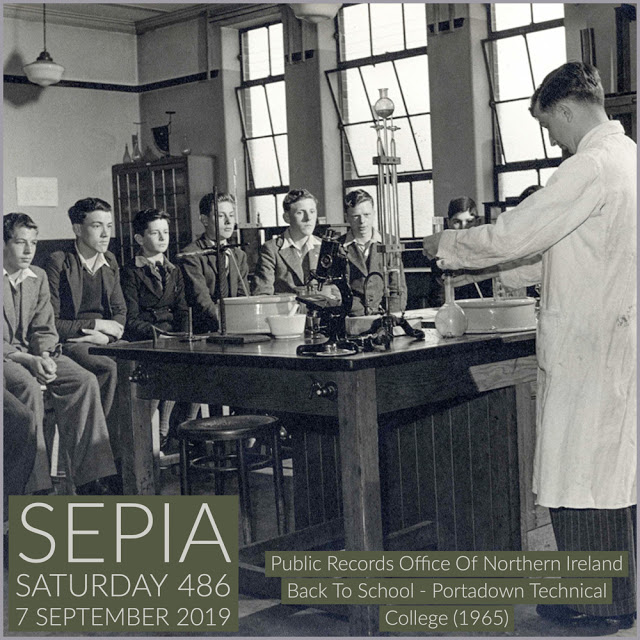
I couldn’t think of anything to match the prompt photo and it is chemo week, so I needed something simple to do. Somewhere along the line, I remembered my grandmother Eveline Hoskins making charcoal crystal gardens with me a couple of times when I lived with her as a young girl – so that’s what I settled on. Doesn’t require a lot of research or brain power and I had the fun of making (with some stumbles) a couple of crystal gardens.
I couldn’t find much on the history of charcoal crystal gardens and only two vintage photos. There are apparently a few references in the 1700s, but charcoal crystal gardens gained popularity during the Depression and are sometimes referred to as Depression flowers. All of the items needed were common household chemicals usually found in one’s home.
Here are a couple of photos I found on the site with the recipe I used;

Most gardens were made in a glass pie plate or a bowl, not like the vase above. I chose glass pie plates and made two – one with charcoal briquettes (without lighter fluid!) and one with the leftovers from a wood burning fireplace that a friend supplied.
Since my grandparent’s home was heated by a coal stove, getting a few small pieces of coal was easy enough. Charcoal briquettes also work, and my little bit of research says you just need a porous base: broken flower pot, pieces of brick – even a sponge. I think my grandmother just sprinkled each item over the coal, but the recipes on the internet have you mix them together and pour over the coal.
The ingredients are basically equal amounts of salt, bluing, and water, and a lesser amount of ammonia. I used 6 Tablespoons of the first three and 1 Tablespoon of ammonia and divided between the two as I didn’t have enough bluing to make two batches – I tried to buy more, but the two stores I went to didn’t have it. Some recipes leave out the ammonia – especially if making with children – which I think slows the process but still works.
Here is my first step, charcoal briquettes on the left, burnt wood on the right:
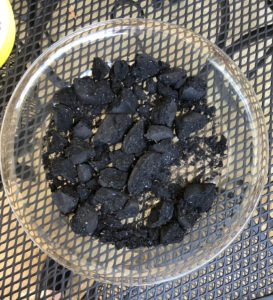
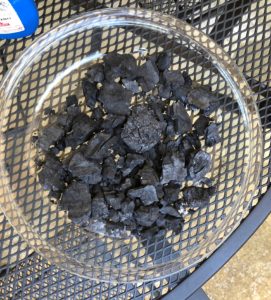
There is an excess of salt that doesn’t dissolve, so it was kind of a sludge that I ended up distributing as best I could.
One of my stumbles was that I never considered that I didn’t have a supply of food coloring in the pantry. If you are good with all white crystals that isn’t a problem, but I wanted a colorful garden like my Grandma and I made. All I could find at first was a little bit of blue food coloring, so I added what I had and went back to the cupboard to see what I could do. I found some paste food coloring that is used for cake decorating. With my weak hands, I couldn’t open a couple of them, but did get a reddish one and more blue, so I diluted the paste in water. When I went back to my garden, it had already started to grow!

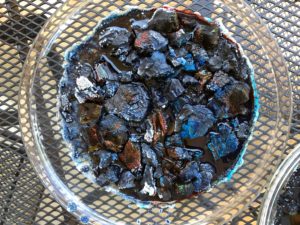
Added the other food coloring and in an hour had this:

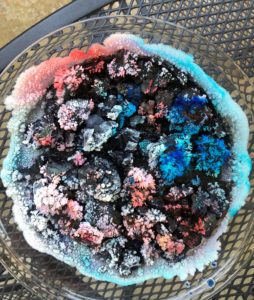
By bedtime, more crystals had grown and were overflowing the pie plate. It was also losing color as the new crystals had not taken on the food coloring. Guess I needed more. By this time, I found some red food coloring, so after taking this photo, I put a little red on and the crystal I poured it on just dissolved away. (It was replaced by morning, so no big deal, really.)
Bedtime:
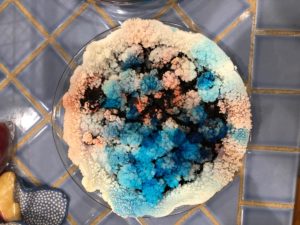

I also ended up with red food coloring on my hands and a little on my shirt, so beware. Also the bluing stains.
It was a fun little thing to do and think of my grandmother in the process.

Please visit the laboratories of other Sepia Saturday participants here.


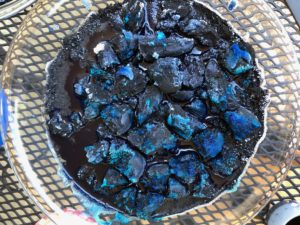
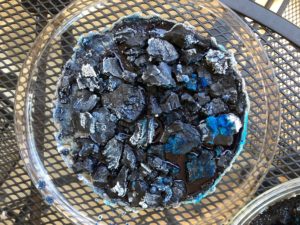
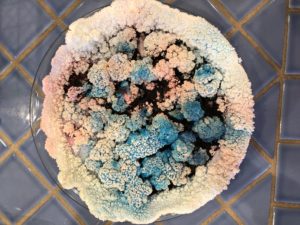
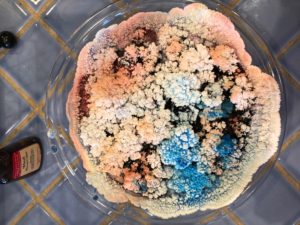
I’ve never heard of, or seen such a thing. How fun. And science to boot! Neat post.
Thanks!
I’ve never heard of this either…so it’s great that your grandmother taught that to you! Have a great weekend!
I thought someone else would have done this, but not anyone in this group, I guess.
I too have led a very sheltered life and do not remember being taught how to make crystal gardens. I was never very keen on science at school but if someone had taught me a bit at home, maybe I would have been a bit more confident. Having said that I do remember being fascinated with a microscope set as a child and looking at my blood on a glass plate was pretty incredible. I am now going off to see if I can find some charcoal! Hope your week is not too awful with the chemo.
We have the same experience and attitude towards science.
I had trouble coming up with science connections at school. Just Bunsen burners and having to dissect a frog. Ugh! Worst days after this week’s chemo coming to an end, so better days ahead!
This is so cool! I never heard of these.
Glad you enjoyed it.
Very cool post. This is a new one on me, but your photos and instructions make the process easy to follow. They say the best writing draws from all the senses — and you have certainly evoked a powerful memory here of a fun “experiment” you shared with your grandmother. Well done!
Thank you. She was a hard working woman at home, but also liked to take some time for something a little fun or different.
I think you’ve produced a perfect match for our chemistry lab tbeme! You’ve also inspired everyone to try home science experiments. I like how the crystals resemble coral reefs as well as Chrysanthemums or even cauliflower.
They really do look like cauliflower – especially now that there are some colored varieties in the stores.
I remember my mother doing this project with the coal and the food coloring. We found it fascinating.